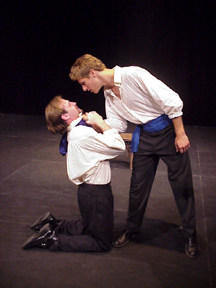
(845) 246-6944
· info@ArtTimesJournal.com
|
|
Action,
Words and Speech
By R.W. BETHUNE
ART TIMES November 2005
What about the playwright? I would say this: that the playwright
will be effective to the extent that the words the playwright gives to
the character are in themselves visceral, physical actions. The playwright
does not merely write language; the playwright writes utterance; the words
put on paper are indications of utterance, not merely of verbal ideation.
I rather like an idea I heard a long
time ago—I donít know where any more. Itís simply this: there are
fundamentally two human responses: ďI like itĒ and ďI donít like it.Ē
Now, in the theater, we are taught always to raise the stakes as high
as possible; so we should do that with these: ďI love itĒ and ďI hate
it.Ē
Now, if you love it, what do you want
to do? You want to draw it toward you. And if you hate it? You want to make
it go away. And itís amazing how far you can go as an actor with just those
two fundamental ideas, provided you also follow a third basic principle:
Engage. You do not turn away; you do not ignore; you do not deny what is
there. You love it or hate it with all your senses, mind and soul, and you
do and do fully whatever it is that will draw it to you or make it go away,
and you remain fully engaged with it at all times, and you are there. You
can refine, you can elaborate, you can explore to your heartís content,
but be sure to do those three things.
So, there you are, playwright. Thatís
your brief. What do your characters do—love or hate? What will they
do to bring it closer or drive it away? What is the nature of their engagement?
Live with them and their story until you find out.
Now itís your turn, director. What
do you do? You arenít putting the words on the paper; you arenít performing
the actions on the stage. You are the eye, the ear, the watching and listening
heart; guide your actors to what you find in your playwrightís work. If
your playwright is there, so much the better; you can be the eye and ear
and heart for the playwright as well as the actors. But whatever you do,
see to it that the action hits home, that it makes a difference out in
the seats where you are. If you canít resist ideas, fine, put your ideas
up there, but remember that an idea is good for maybe thirty seconds if
itís utterly superb, and youíve asked the audience into your space for
at least ninety minutes if not a couple hours or more. Give them the steak,
not just the sizzle.
In the end, the great, inimitable,
irreplaceable strength of the theater is the power of the live action,
engagement in the direct presence, the living, breathing flow of love
and hate here in the same room. We donít want that in the real world;
we shy away from it, or if necessary get up and run like blazes; in the
theater we can stand it, we want it; itís what we go there for. Thatís
what the theater does: love, hate and engage.
 Scott
Blair as Oliver and Patrick Morgan as Orlando in As You Like
It by William Shakespeare—Brass Tacks Ensemble, Performance
Network, Ann Arbor, MI.
Scott
Blair as Oliver and Patrick Morgan as Orlando in As You Like
It by William Shakespeare—Brass Tacks Ensemble, Performance
Network, Ann Arbor, MI.